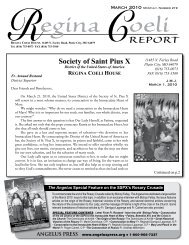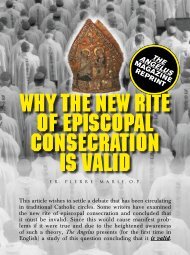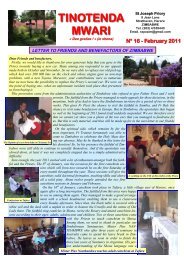Is Feeneyism Catholic? - Society of St. Pius X
Is Feeneyism Catholic? - Society of St. Pius X
Is Feeneyism Catholic? - Society of St. Pius X
You also want an ePaper? Increase the reach of your titles
YUMPU automatically turns print PDFs into web optimized ePapers that Google loves.
T HE TEACHING OF THE CHURCH 85<br />
As soon as she ended this divine supplication, a strong and<br />
powerful grace came forth from the source <strong>of</strong> all graces, the adorable<br />
Heart <strong>of</strong> our Jesus, and enlightened the soul <strong>of</strong> the poor dying<br />
Jewess and triumphed instantaneously over her resistances.<br />
This soul turned around with love and confidence towards Him<br />
whose mercy followed her even in the arms <strong>of</strong> death and she said<br />
(in her heart): “O Jesus, God <strong>of</strong> the Christians, God that my son<br />
adores, I believe, I hope in Thee, have mercy on me!”<br />
The pious soul who had this vision was a complete stranger to<br />
Fr. Hermann; the fact <strong>of</strong> her vision is not only known by the letter<br />
she wrote to Fr. Hermann, but also in her own family by her<br />
nephew Emile Baumann; it is greatly authenticated by the prophecy<br />
<strong>of</strong> the holy Curé <strong>of</strong> Ars. 118<br />
The second example is that <strong>of</strong> the “Canutes,” a tribe near<br />
Chartres in France. When the first missionaries arrived there, they<br />
found druids who worshipped “the Virgin who shall conceive.”<br />
They told them, “We know that Virgin, she is called Mary; we<br />
preach to you her Son, Jesus Christ, the Savior <strong>of</strong> the world!” And<br />
the whole tribe was converted. It was not exactly a “conversion”<br />
but rather a fulfillment <strong>of</strong> their already existing faith in the “Son<br />
<strong>of</strong> the Virgin.” What must have happened, is that a pious soul had<br />
received a revelation from an angel that “The Virgin shall conceive,<br />
and she shall bring forth a child. He is the Savior <strong>of</strong> the<br />
world!” They had not yet baptism, but by believing in the “Son <strong>of</strong><br />
the Virgin” and living worthily <strong>of</strong> Him, they could be saved. 119<br />
Conclusion: eodem Sensu, eademque Sententia<br />
Dear reader, arrived at this point, when we consider together<br />
all this concordant teaching <strong>of</strong> the Church, we can have but one<br />
faithful attitude, that <strong>of</strong> receiving this teaching, holding fast to it<br />
in eodem sensu, eademque sententia–in the same sense and the same<br />
words (I Cor. 1:10). The doctrine <strong>of</strong> baptism <strong>of</strong> blood and baptism<br />
<strong>of</strong> desire is inseparably linked by the Church to the dogma<br />
outside the Church there is no salvation. It belongs to the very proper<br />
understanding <strong>of</strong> that dogma, so much that if one denies it, he<br />
118<br />
Flèche de Feu, pp.259, 260.<br />
119 Very short reference to this is made in Chartres Cathedral, by Malcolm<br />
Miller.











